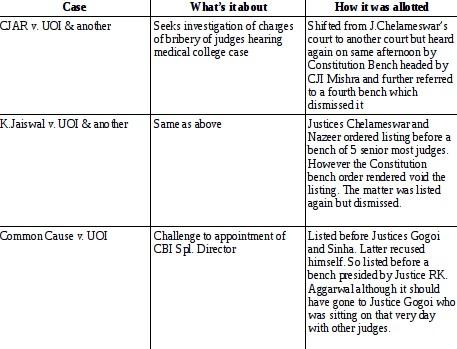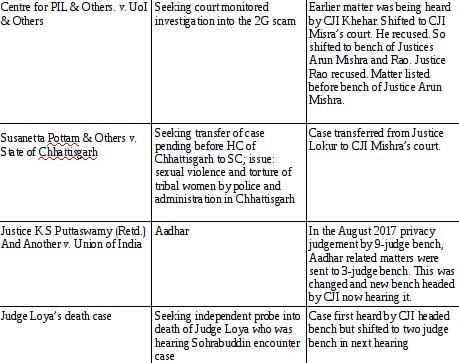Supreme Court Judges’ Mutiny – A Whiff of Fresh Air

Four senior judges of the Supreme Court stunned the country on 12 January 2017 by holding a press conference and protesting against some of the ways in which the Chief Justice is running the Court’s affairs. Never before has such an exposure of the apex court’s inner workings been done. Many former judges and advocates have expressed shock and disappointment at what happened while many others have welcomed the move. It is uncharted territory for the country’s establishment and for the common people too. For most people, the issues raised by the judges in a letter they released to the media are too complex to understand. Mainstream media is giving its own spin to the whole thing. Newsclick explains the basic issues:
What is it all about?
The four judges were protesting against the way cases are allotted to different benches of the Supreme Court. This allotment is done by the Chief Justice who is considered to be the head of the administrative work of the Court. By convention he allots the cases in consultation with other senior judges. Those who have been dealing with certain kinds of cases are allotted similar cases. But in recent months, this process had become arbitrary, said the protesting judges. Although they were too polite and proper to actually name such cases, the Campaign For Judicial Accountability and Reforms (CJAR), an advocacy body of legal experts and jurists, listed out some important instances in a statement on 12 January. These are (as per CJAR):


So, what’s the problem with this shifting around of cases from one bench to another?
It is being thought that sensitive cases that relate to govt. policy (like Aadhar), or a state govt. (like Chhattisgarh), or even a personality (like Judge Loya’s death who was hearing Sohrabuddin case) are being shifted to less experienced and, some say, more pliable benches in the hope of getting a more positive judgement. The medical college case involves charges of bribery of judges and it is possible that there may be some worried people who want it shifted, according to reports. CJI Mishra was hearing the case earlier. In short, “bench fixing” as it is called, may have destroyed the way justice is to be delivered. The CJAR statement says “Though the senior judges did not mention it, but it is clear that the assignment of such cases to certain junior judges was for achieving a particular result, which in most cases can be seen to be in tune with the wishes of the government. The subversion of justice in this manner is particularly dangerous when there is a government in place which is trampling on peoples’ fundamental rights and constitutional values.”
Should the SC judges have gone public with their grievances? Couldn’t they have sorted it out internally?
They tried but they failed, it seems. They have been discussing the matter with the CJI all these days but to no avail. On 12 January itself, before holding the press conference, they had gone to the CJI’s home in the morning and tried to convince him not to shift the Judge Loya case as it was an important and sensitive matter. But he refused, according to them. In such a situation, isn’t it better to appeal to the people of India? Otherwise the rot within would have got hushed up and rule of law itself would be compromised. So, the judges protest is in fact a very welcome whiff of fresh air, a ray of light thrown on an otherwise opaque system. In the larger picture it is a healthy development.
Were there any other issues raised by the four judges?
Another issue was regarding the Memorandum of Procedure (MoP). This is a document that lays down how judges are to be selected for High Courts and the Supreme Court. This has been a matter of tussle between the judiciary and the govt. The govt. had proposed a National Judicial Appointments Commission and brought in the 99th Constitution amendment for it in 2015. But the Supreme Court struck it down in 2016, thus reviving the Collegium system. In this system, 5 senior judges – the CJI and the four next senior most judges – recommends judges names for selection. How exactly this is to be done by the Collegium is the MoP. The protesting four judges are all members of the Collegium. They said that they had sent the MoP to the govt. back in March 2017 for its response but since there was dead silence from the other end, they are assuming that the govt. has accepted it. This was as much a veiled criticism of the CJI for not pursuing the matter. One implication of this is that vacancies in High Courts will continue. Many Supreme Court judges will also retrire this year and there will be uncertainity about appointments then too.
What should happen now?
There is need to quickly and effectively stem the rot and rectify what has gone wrong. Otherwise, the govt. can take advantage of the situation to weaken the judiciary and bring it under its thumb. The primarty onus of this lies with the current CJI who has a few more months of tenure left. CJI should call a full court meeting (all judges of Supreme Court) and reset the rules in line with established convention and giving due position to the senior judges. At his initiative, mutual confidence can be rebuilt. The other junior judges too need to take a position in defence of the institution for which the senior four judges are fighting. And, the people of India should strongly support the protesting judges and press for rectification. They should demand that the judiciary’s independence be firmly preserved and guarded against subversion from within and without. As the CJAR says, “The extraordinary initiative undertaken by the four judges provides a tremendous opportunity to usher in much needed reforms in the judiciary. CJAR hopes that appropriate steps will be urgently taken to address the issues raised by the judges.”
Get the latest reports & analysis with people's perspective on Protests, movements & deep analytical videos, discussions of the current affairs in your Telegram app. Subscribe to NewsClick's Telegram channel & get Real-Time updates on stories, as they get published on our website.
























